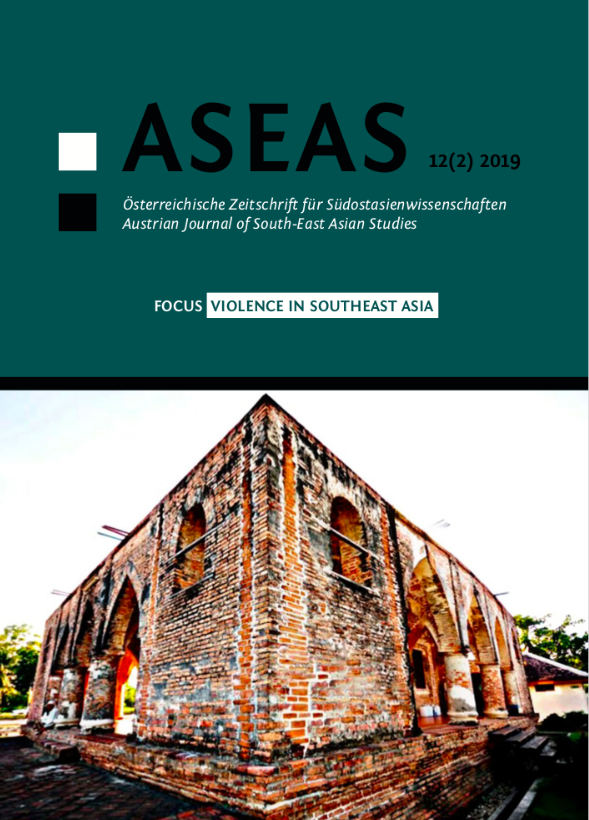Forced Migration in Southeast Asia
A Brief Overview of Current Research
DOI:
https://doi.org/10.14764/10.ASEAS-0024Keywords:
Current Research, Forced Migration, Persons of Concern, Southeast AsiaAbstract
Southeast Asian countries host significant numbers of forcibly displaced populations, both within countries and across borders. This brief review paper provides a basic overview on recent forced migration research in Southeast Asia for the period 2013 to 2018. To this end, a keyword search with two predefined sets of search terms was carried out in the Web of Science database in September 2018. The identified research literature corpus was then analyzed regarding persons of concern, study site(s) (country/ies) as well as main drivers of migration. The results show that the major part of studies focuses on refugees and asylum seekers in the region’s main host countries, namely Thailand, Malaysia, and Indonesia. This correspondence between current research trends and the distribution of refugees and asylum seekers in Southeast Asia could, however, not be identified for internally displaced persons (IDPs). Although Southeast Asian countries account for a substantial share of worldwide IDPs, only a very limited number of identified studies focus on this group of persons of concern.
References
Amer, R. (2009). The Association of Southeast Asian Nations’ (ASEAN) conflict management approach revisited: Will the charter reinforce ASEAN's role? Austrian Journal of South-East Asian Studies, 2(2), 6-27.
Association of Southeast Asian Nations. (2013). ASEAN Human Rights Declaration (AHRD) and the Phnom Penh Statement on the Adoption of the AHRD. Jakarta: The ASEAN Secretariat.
Black, R., Adger, W. N., Arnell, N. W., Dercon, S., Geddes, A., & Thomas, D. (2011). The effect of environmental change on human migration. Global Environmental Change, 21, 3-11.
Fiddian-Qasmiyeh, E., Loescher, G., Long, K., & Sigona, N. (Eds.). (2014). The Oxford handbook of refugee and forced migration studies. Oxford: Oxford University Press.
Harzing, A. W., & Alakangas, S. (2016). Google Scholar, Scopus and the Web of Science: a longitudinal and cross-disciplinary comparison. Scientometrics, 106(2), 787-804.
Internal Displacement Monitoring Centre. (2018). Country Profiles. Retrieved from http://www.internal-displacement.org/countries
Marinova, N. (2017). Human Smuggling and Human Trafficking. Oxford Research Encyclopedia of International Studies. Retrieved from https://oxfordre.com/internationalstudies/view/10.1093/acrefore/9780190846626.001.0001/acrefore-9780190846626-e-216
McConnachie, K. (2014): Forced migration in Southeast Asia and East Asia. In E. Fiddian-Qasmiyeh, G. Loescher, K. Long, & N. Sigona (Eds.), The Oxford handbook of refugee & forced migration studies (pp. 626-638). Oxford: Oxford University Press.
Petcharamesree, S. (2016). ASEAN and its approach to forced migration issues. The International Journal of Human Rights, 20(2), 173–190.
Pugh, M. (2004). Drowning not waving: Boat people and humanitarianism at sea. Journal of Refugee Studies, 17(1), 50-69.
Renshaw, C. (2015). Human trafficking in Southeast Asia: Uncovering the dynamics of state commitment and compliance. Michigan Journal of International Law, 37(4), 611–659.
Turton, D. (2003). Conceptualizing Forced Migration. Refugee Studies Centre Working Paper No. 12. Oxford: Refugee Studies Centre. Retrieved from https://www.rsc.ox.ac.uk/files/files-1/wp12-conceptualising-forced-migration-2003.pdf
Ullah, AKM A., & Hossain, M. A. (2011). Gendering Cross-Border Networks in the Greater Mekong Subregion: Drawing Invisible Routes to Thailand. Austrian Journal of South-East Asian Studies, 4(2), 273-289.
United Nations Educational, Scientific and Cultural Organization. (2008). The Hague Process on Refugees and Migration. People on the Move: Handbook of Selected Terms and Concepts. Retrieved from http://unesdoc.unesco.org/images/0016/001636/163621e.pdf
United Nations High Commissioner for Refugees. (2019). Gobal Trends. Forced Displacement in 2018. Retrieved from https://www.unhcr.org/globaltrends2018/
United Nations High Commissioner for Refugees. (2018a). Rohingya emergency. Retrieved from http://www.unhcr.org/rohingya-emergency.html
United Nations High Commissioner for Refugees. (2018b). Persons of concern to UNHCR. Retrieved from https://www.unhcr.org/ph/persons-concern-unhcr
United Nations High Commissioner for Refugees. (2018c). Gobal Trends. Forced Displacement in 2017. Retrieved from https://www.unhcr.org/globaltrends2017/
United Nations High Commissioner for Refugees. (2016). Mixed Movements in South-East Asia 2016. Retrieved from https://unhcr.atavist.com/mm2016.
Downloads
Published
Issue
Section
License
Copyright (c) 2019 Society for South-East Asian Studies (SEAS)

This work is licensed under a Creative Commons Attribution-NonCommercial-NoDerivatives 4.0 International License.
For all articles published in ASEAS before December 2014 and after July 2022, copyright is retained by the authors. For articles published between January 2015 and June 2022, the Society for South-East Asian Studies (SEAS) is the copyright holder. Articles published in ASEAS before December 2019 are licensed under the following Creative Commons License: Attribution-NonCommercial-NoDerivs 3.0 Unported. Articles published after that date are licensed under the following Creative Commons License: Attribution-NonCommercial-NoDerivs 4.0 International. In both cases, this means that everybody is free to share (to copy, to distribute, and to transmit the work) under the following conditions:
-
Attribution — You must give appropriate credit, provide a link to the license, and indicate if changes were made. You may do so in any reasonable manner, but not in any way that suggests the licensor endorses you or your use.
-
NonCommercial — You may not use the material for commercial purposes.
-
NoDerivatives — If you remix, transform, or build upon the material, you may not distribute the modified material.


